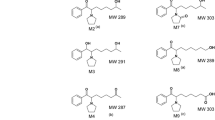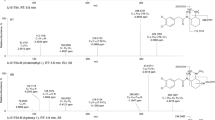Summary
Metabolic pathways and the pharmacokinetic profile of mefenorex ((±)N-(3-chloropropyl)-1-methyl-2-phenylethylamine), and its main metabolite amphetamine (1-methyl-2-phenylethylamine) have been studied in two healthy volunteers, after a single oral dose of mefenorex (1.2 mg/kg body weight for a male subject and 2.4 mg/kg body weight for a female subject). Urinary concentrations were determined by gas chromatography (GC) and metabolite structure was identified by GC/MS following derivatization of urine extracts. The ratio of this metabolite to unchanged drug in urine samples, collected up to 5 h following administration, was essentially the same after either of the administered doses.
The calculated Kel for mefenorex after the higher dose was in the range of 0.191–0.272 h−1, with a biological half life (t1/2) of 3.98–2.55 h, depending on the method of calculation used. The elimination of amphetamine was much slower with a Kel ranging from 0.039–0.073 h−1 and a t1/2 from 9.5–17.8 h. Depending on the dose administered, the rate constant of metabolite formation was 0.129 and 0.685 h−1 for low and high doses, respectively.
Urinary excretion of Rondimen® amounted to 11.9% within 72 h after administration. Of this amount, 1.5% represented unchanged drug and 10.4% represented metabolites. In addition to amphetamine 3 other metabolites were identified:p-hydroxy mefenorex,p-hydroxy amphetamine andp-hydroxy-m-methoxy mefenorex.
Similar content being viewed by others
References
Van Blum J.E. (1969): Experimentelle Untersuchungen mit dem neuen Appetithemmer N-(3-Chloropropyl)-1-methyl-2-phenyl-äthylamin-hydrochlorid (Ro4-5282). Arzneimittelforschung, 19, 748–755.
Caldwell J. (1976): The metabolism of amphetamines in mammals. Drug Metab. Rev., 5, 216–280.
Smith R.L., Dring L.G. (1970): Patterns of metabolism of β-phenylisopropylamines in man and other species. In: Costa E., Garattini S. (eds). Amphetamines and Related Compounds. New York, Raven.
Catlin D., Cowan D., Donike M., Fraisse D., Oftebro H., Rendić S. (1992): Testing urine for drugs. J. Aut. Chem., 14, 85–92.
Ambre J., Ruo T.I., Nelson J., Belknap S. (1988): Urinary excretion of cocaine, benzoylecgonine, and ecgonine methyl ester in humans. J. Anal. Toxicol., 12, 301–306.
Rendić S. (1989): Drug metabolism in identification of drug misused in sport by gas chromatography-mass spectrometry. Acta Pharm. Jugosl., 39, 173–180.
Rendić S. (1991): Identification of drug metabolites by gas chromatography-mass spectrometry. In: Shipe J.R., Savoy, J. (eds) Drugs in Competitive Athletics. Oxford, Blackwell, pp. 55–60.
Fujita T., Iwasa J., Hansch C. (1964): A new substituent constant, π, derived from partition coefficients. J. Am. Chem. Soc., 86, 5175–5180.
Rekker R.F. (1977): The hydrophobic fragmental constant, its derivation and application. New York, Elsevier.
Donike M. (1975): N-Trifluoroacetyl-O-trimethylsilyl-phenoalkylamine Darstellung und Massenspezifischer Gaschromatographischer Nachweis. J. Chromatogr., 103, 91–112.
Donike M., Derenbach J. (1976): Die Selective Derivatisierung unter kontrollierten Bedingungen: Ein Weg zum Spuren-Nachweins von Aminen. Z. Anal. Chem., 279, 128–131.
Wagner J.G. (1975): Fundamentals of Clinical Pharmacokinetics. Hamilton, IL, Drug Intelligence Publications.
Gibaldi M., Perrier D. (1982): Pharmacokinetics. New York, Dekker.
Grunewald G.L., Pleiss M.A., Gatchell C.L., Pazhenchevsky R., Rafferty M.F. (1984): Gas chromatographic quantitation of underivatized amines in the determination of their octanol 0.1 M sodium hydroxide partition coefficient by the shake-flask method. J. Chromatogr., 292, 319–331.
Becket A.H., Rowland M. (1965): Urinary excretion kinetics of methylamphetamine in man. J. Pharm. Pharmacol., 17, 109S-114S.
Caldwell J., Dring L.G., Williams R.T. (1972): Metabolism of [C14]methamphetamine in man, the guinea pig and the rat. Biochem. J., 129, 11–22.
Becket A.H., Brookes L.G., Shenoy E.V.B. (1969): Urinary excretion of the drug and its main metabolites in man, after the administration of (±), (+) and (-) ethylamphetamine. J. Pharm. Pharmacol., 21, 151S-156S.
Becket A.H., Shenoy E.V.B. (1973): The effect of N-alkyl chain length and stereochemistry on the absorption, metabolism and urinary excretion of N-alkyl amphetamines in man. J. Pharm. Pharmacol., 25, 793–799.
Becket A.H., Tucker G.T. (1968): Application of the analogue computer to pharmacokinetic and biopharmaceutical studies with amphetamine type compounds. J. Pharm. Pharmacol., 20, 174–193.
Vree T.B., van Rossum J.M. (1970): Kinetics of metabolism and excretion of amphetamines in man. In: Costa E., Garattini S. (eds) Amphetamines and Related Compounds. New York, Raven, pp. 165–190.
Becket A.H., Salmon J.A., Mitchard M. (1969): The relation between blood levels and urinary excretion of amphetamine under controlled acidic and under fluctuating urinary pH values using [C14]amphetamine. J. Pharm. Pharmacol., 21, 251–258.
Author information
Authors and Affiliations
Rights and permissions
About this article
Cite this article
Rendić, S., Slavica, M. & Medić-Šarić, M. Urinary excretion and metabolism of orally administered mefenorex. Eur. J. Drug Metab. Pharmacokinet. 19, 107–117 (1994). https://doi.org/10.1007/BF03188831
Received:
Issue Date:
DOI: https://doi.org/10.1007/BF03188831




